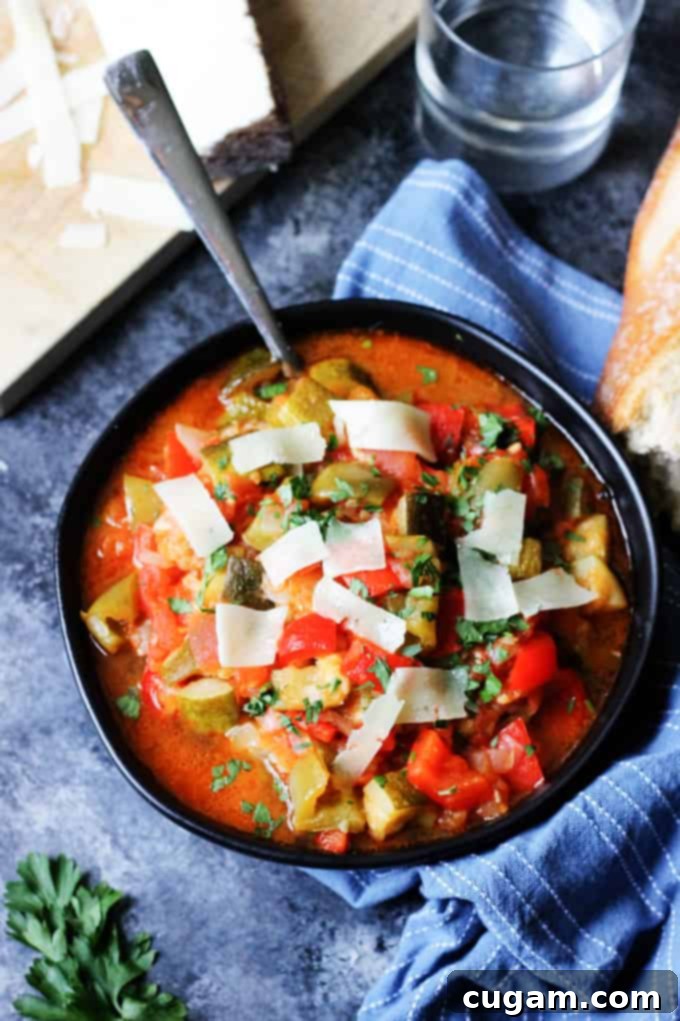Pisto Manchego: The Ultimate Spanish Ratatouille Recipe for Summer
Pisto Manchego, often affectionately called ‘Spanish Ratatouille,’ is a quintessential Mediterranean vegetable stew hailing from the sun-drenched region of La Mancha. This vibrant and wholesome dish masterfully combines fresh, seasonal ingredients like bell peppers, onions, ripe tomatoes, tender courgettes (zucchini), and sometimes even eggplant. Slowly simmered in rich olive oil, it transforms into a deeply flavorful and aromatic concoction. Universally loved for its versatility, Pisto Manchego can be enjoyed on its own, enhanced with a fried egg, accompanied by cured ham, or simply adorned with shavings of Manchego cheese. It’s a celebration of summer’s bounty, promising a taste of Spain in every spoonful.
If you’re looking for other delightful Spanish recipes featuring fresh summer vegetables, be sure to explore our Andalusian Gazpacho, the creamy Salmorejo Soup, or a hearty Spanish Tuna Stew. These dishes perfectly capture the essence of Spanish summer cuisine.
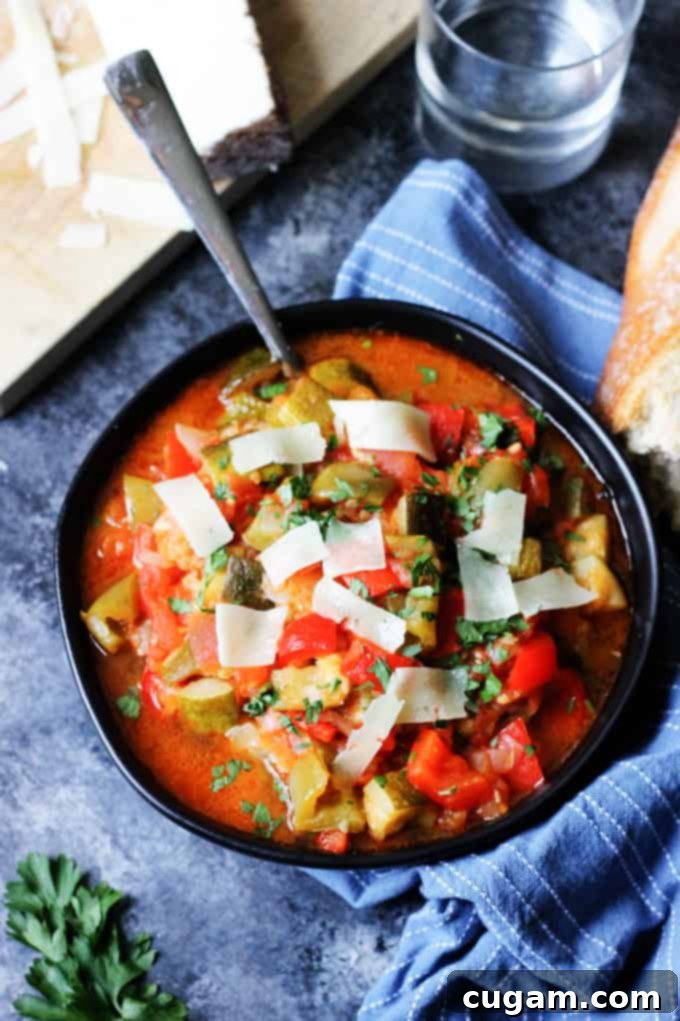 This post may contain affiliate links. I get commissions for purchases made through the affiliate links. You can read my disclosure policy HERE.
This post may contain affiliate links. I get commissions for purchases made through the affiliate links. You can read my disclosure policy HERE.
What Exactly is Pisto Manchego? Exploring Spain’s Beloved Vegetable Stew
Pisto Manchego is more than just a vegetable stew; it’s a culinary cornerstone of Spanish cuisine, deeply rooted in the heart of the La Mancha region. This iconic dish is a testament to the simplicity and richness of Mediterranean cooking, utilizing readily available seasonal vegetables such as sweet peppers, pungent onions, succulent tomatoes, tender zucchini, and often earthy eggplant. These ingredients are lovingly simmered in the finest olive oil, allowing their natural flavors to meld and intensify into a harmonious, comforting dish.
The La Mancha Connection: A Taste of Central Spain
La Mancha, a vast and culturally rich plateau in central Spain, is famous for many things: its windmills immortalized by Don Quixote, its world-renowned Manchego cheese, and, of course, its vibrant culinary traditions. Pisto Manchego embodies the spirit of this region, reflecting its agricultural bounty and the Spanish philosophy of cooking with fresh, high-quality ingredients. The term “Pisto” itself refers to a vegetable stir-fry or stew, while “Manchego” proudly denotes its origin from La Mancha, giving the dish a strong sense of place and heritage. It’s a dish that tells a story of the land, the sun, and the simple, honest flavors of Spanish gastronomy.
Pisto Manchego vs. French Ratatouille: A Culinary Debate
It’s almost impossible to discuss Pisto Manchego without drawing comparisons to its famous French cousin, Ratatouille. The similarities are striking, leading many to affectionately call Pisto Manchego ‘Spanish Ratatouille.’ Both are vibrant vegetable stews that celebrate the summer harvest, simmered slowly to create a medley of tender vegetables bathed in a rich sauce. However, a friendly rivalry exists, with some Spaniards passionately asserting that Pisto predates Ratatouille, claiming its culinary journey from La Mancha, through the Basque Country, and eventually into France. While historical records for such specific culinary migrations can be murky, the debate underscores the deep cultural pride associated with these dishes.
Beyond historical precedence, subtle differences often distinguish the two. Ratatouille typically features chunkier cuts of vegetables, creating a more rustic texture and allowing the individual components to stand out more. Pisto, on the other hand, often calls for more finely diced ingredients, resulting in a slightly smoother, more integrated stew where the flavors are thoroughly blended. Additionally, traditional Pisto Manchego frequently incorporates a hint of Spanish smoked paprika (pimentón), lending a distinctive smoky depth and a beautiful reddish hue that is less common in classic Ratatouille. This subtle spice is a key differentiator, adding a layer of Spanish authenticity. Both are undeniably delicious, but these nuances offer unique character to each dish, making them worth exploring in their own right. The essence, however, remains the same: a celebration of garden-fresh vegetables cooked to perfection in olive oil, a cornerstone of Mediterranean diets.
A Global Culinary Heritage: Mediterranean Vegetable Stews
The concept of a slow-simmered vegetable stew is not unique to Spain or France; it’s a culinary thread woven throughout the Mediterranean and beyond. You’ll discover local variations of this beloved dish in countless countries, each with its own regional twist and name. From the flavorful Turkish Imam Bayildi (a rich eggplant dish often incorporating other vegetables) to Greek Briam (a baked medley of vegetables), and various Italian recipes like Caponata (a sweet and sour Sicilian eggplant relish) or Ciambotta (a southern Italian vegetable stew), the principle remains constant: combining fresh, local produce with quality olive oil and aromatic herbs. Even the Hungarian Lecsó, a classic tomato and pepper stew, shares remarkable similarities with Pisto Manchego, highlighting a universal appreciation for the simple elegance and health benefits of cooked vegetables. This widespread popularity speaks to the dish’s timeless appeal and its adaptability to local ingredients and palates.
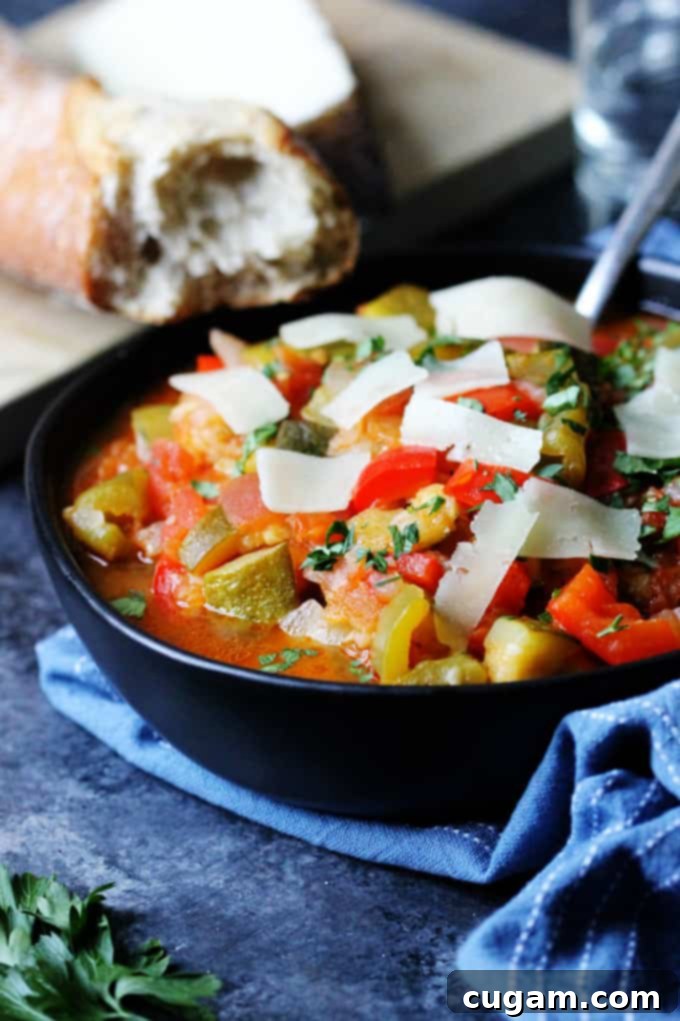
Essential Ingredients for the Perfect Pisto Manchego
Crafting an exceptional Pisto Manchego begins and ends with the quality of your ingredients. It truly comes as no surprise that the better your vegetables, the more sublime your Pisto will be. This is why Pisto Manchego shines brightest during the peak summer months when produce is at its ripest, most flavorful, and abundant. Attempting this dish in the depths of winter with sub-par vegetables simply won’t yield the same vibrant results. For an authentic and unforgettable Pisto, seek out the freshest, ripest, sun-kissed summer vegetables available. Below is a comprehensive guide to the ingredients you’ll need to create this Spanish delight, along with insights into their importance (for exact measurements, detailed instructions, and nutritional information, please refer to the printable recipe card further down):
Key Ingredients and Their Role:
- Spanish or Vidalia Onion: These sweet onion varieties provide a crucial aromatic base for the stew. Their mild sweetness caramelizes beautifully during the initial sauté, adding depth and a foundational flavor without overpowering the other delicate vegetable notes.
- Garlic: An indispensable flavor enhancer in almost all Spanish cuisine, garlic adds a pungent, savory kick that elevates the entire dish. Using freshly chopped garlic, rather than pre-minced, makes a significant difference in the vibrancy of the aroma and taste.
- Green and Red Bell Peppers: These colorful peppers are central to Pisto, contributing natural sweetness, a slight earthiness from the green variety, and a delightful texture once cooked. They add both essential flavor and a beautiful visual appeal to the stew.
- Zucchini (Courgettes): Lending a delicate, slightly sweet flavor and a soft, melt-in-your-mouth texture once cooked, zucchini absorbs the rich tomato and olive oil sauce beautifully. Its presence is vital for achieving the stew’s characteristic consistency and lightness.
- Tomatoes (On the vine, or Roma): The very heart of Pisto Manchego, ripe tomatoes form the luscious, flavorful sauce that binds all the vegetables together. On-the-vine or Roma tomatoes are ideal due to their meaty texture and concentrated, sweet-tart flavor. Peeling them ensures a smooth, refined sauce without any tough, chewy skins.
- Extra Virgin Olive Oil: This isn’t just a cooking fat; it’s a primary flavor component and a hallmark of Mediterranean cuisine. High-quality extra virgin olive oil imparts a fruity, peppery note and a silky richness to the Pisto. Investing in a good quality olive oil is paramount for an authentic Spanish taste.
- Sherry Vinegar: A splash of sherry vinegar is a Spanish secret weapon that elevates Pisto to another level. It provides a bright, acidic counterpoint to the richness of the vegetables, enhancing and balancing all the flavors without making the dish taste sour. If authentic sherry vinegar is unavailable, a good quality red wine vinegar can serve as a suitable substitute.
- Salt & Pepper, to taste: Essential seasonings to bring out and amplify the natural flavors of the vegetables. Adjusting them throughout the cooking process is key to a perfectly balanced and seasoned dish.
- Smoked Spanish Paprika (Pimentón Ahumado) (optional): While Pisto isn’t traditionally spicy, a touch of Spanish smoked paprika adds an incredible depth of flavor and a beautiful reddish hue. It imparts a subtle smoky aroma that is characteristic of many Spanish dishes and is highly recommended for an authentic taste profile. Choose sweet (dulce) for mild flavor, or hot (picante) for a bit of kick.
- Manchego Cheese (optional): Grated or shaved over the finished dish, this semi-hard sheep’s milk cheese from La Mancha adds a nutty, tangy, and creamy element that perfectly complements the vegetables. It’s a delightful nod to the dish’s regional origins and adds a luxurious touch.
- Fresh chopped parsley, for garnish: A sprinkle of fresh parsley adds a pop of vibrant green color and a refreshing herbaceous note, brightening the final presentation and adding a fresh aroma.
The Importance of Seasonal and Quality Produce
Choosing vegetables at their peak ripeness is paramount for Pisto Manchego. Summer-ripe tomatoes burst with natural sweetness and acidity, bell peppers are crisp and vibrant, and zucchini is tender and full of flavor. These qualities are significantly diminished in out-of-season produce, which often results in a watery or bland stew. Visiting a local farmer’s market during summer is the best way to source ingredients that will make your Pisto truly sing. Look for firm, brightly colored vegetables with no blemishes and a fragrant aroma. The difference in taste, texture, and overall enjoyment will be profound, transforming a good pisto into a truly memorable one.
Mastering Pisto Manchego: A Step-by-Step Guide
Creating Pisto Manchego is a simple yet rewarding process, relying on gentle simmering to coax out the best from its fresh ingredients. The beauty lies in the slow melding of flavors, allowing each vegetable to contribute to the rich tapestry of the stew. Follow these steps carefully to achieve a rich, flavorful, and authentic Spanish vegetable stew that tastes like a ray of sunshine:
- Step 1: Prepare Your Vegetables with Precision. Begin by thoroughly washing all your produce. Finely chop your onions and garlic, ensuring the garlic is minced evenly. Next, cut the bell peppers and zucchini into small, uniform squares. This consistent sizing is important for even cooking and a cohesive texture throughout the stew. For the tomatoes, the traditional method involves parboiling them in hot water for approximately 2-3 minutes until their skins begin to crack and loosen. This step makes peeling them incredibly easy, resulting in a smoother, more refined tomato base for your Pisto without any tough skins. Once peeled and slightly cooled, roughly chop them. This meticulous preparation is foundational for the dish’s success, guaranteeing each component cooks perfectly.
- Step 2: Initiate the Sauté for the Aromatic Base. In a Dutch oven or a heavy-bottomed pan with a tight-fitting lid, preheat your extra virgin olive oil over medium heat. Once shimmering and hot but not smoking, add the chopped onions. Sauté them, uncovered, for about 5 minutes, stirring occasionally. The goal here is to soften the onions and allow them to become translucent, releasing their natural sweetness and aromatic compounds that will form the flavor backbone of your Pisto. Avoid browning them too quickly, as this can lead to a bitter taste.
- Step 3: Introduce the Fragrant Garlic. After the onions have softened, add the chopped garlic to the pan. Continue to sauté for just a couple more minutes, stirring frequently. Garlic cooks much faster than onions, so adding it later prevents it from burning. You’re looking for its fragrant aroma to develop and infuse into the olive oil, but not for it to brown.
- Step 4: Incorporate the Bell Peppers. Next, add your chopped green and red bell peppers to the pan. Cook them for another 5 minutes, stirring occasionally, until they start to soften slightly but still retain a bit of their vibrant color and a pleasant bite. This layering of ingredients ensures each vegetable gets adequate time to release its distinct flavors and textures.
- Step 5: Simmer to Perfection. Now, reduce the heat to low. Add the prepared zucchini and chopped tomatoes to the pan. Season generously with a little salt and freshly ground black pepper. Place the lid securely on the pot and let the Pisto gently simmer, covered, for approximately 30 minutes. This slow cooking process is crucial; it allows the vegetables to release their liquids, meld their flavors deeply, and become wonderfully tender without turning mushy. Remember to stir occasionally (every 5-10 minutes) to prevent sticking to the bottom of the pan and ensure even cooking. The stew will gradually thicken into a rich, cohesive, and incredibly aromatic sauce as the vegetables break down.
- Step 6: Final Seasoning and Flavor Enhancement. After simmering, remove the lid and give the Pisto a taste. This is your chance to adjust the seasoning with more salt and pepper as needed to perfectly balance the flavors. This is also the moment to add the optional Spanish smoked paprika, if you’re using it, along with the sherry vinegar. Stir everything together thoroughly. The paprika will infuse a warm, earthy, and smoky note, while the vinegar will provide a vital touch of acidity that brightens the entire dish, creating a beautifully rounded and complex flavor profile.
- Step 7: Serve with Authentic Spanish Flair. Ladle the finished Pisto Manchego into your favorite serving bowl. For an extra touch of richness and authentic flavor, drizzle a little more high-quality extra virgin olive oil over the top just before serving. Generously shave or grate some Manchego cheese over the warm stew – its nutty, tangy profile is a perfect complement. Finally, sprinkle with fresh chopped parsley for a pop of color and a refreshing herbaceous finish. Serve immediately with plenty of crusty bread or a crisp baguette for dipping and soaking up every delicious drop. ¡Buen provecho! (Enjoy your meal!)
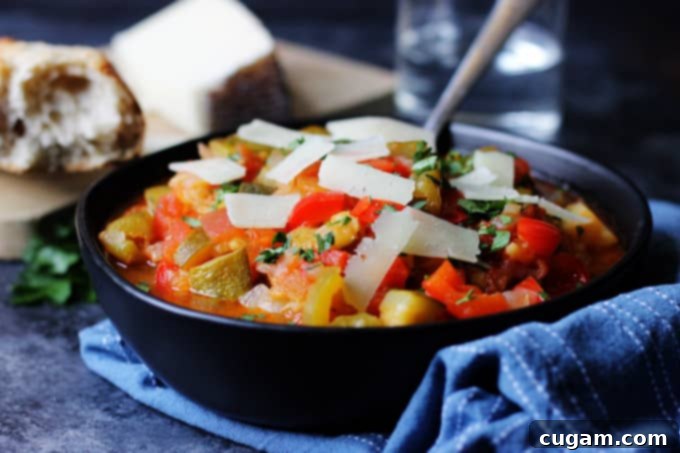
Customizing Your Pisto: Creative Recipe Alterations
One of the beauties of Pisto Manchego is its adaptability. While the classic recipe is perfect as is, it also lends itself wonderfully to customization based on personal preference, dietary needs, or what fresh produce you happen to have on hand. Don’t be afraid to experiment and make this versatile dish truly your own:
- Embrace Eggplant: For a richer, more substantial stew, introduce eggplant. You can use it in place of zucchini or combine both for an even greater variety of textures and earthy flavors. If using eggplant, consider cubing it, salting it lightly, and letting it sit for 30 minutes to an hour before rinsing and patting dry. This step helps to draw out excess water and reduce any potential bitterness.
- Vegan & Vegetarian Friendly: The base Pisto recipe is naturally vegetarian and easily made vegan by simply omitting the optional Manchego cheese and fried egg. It’s a fantastic plant-based meal bursting with flavor and nutrients, perfectly aligning with a healthy Mediterranean diet.
- Pepper Power: While green and red bell peppers are traditional, feel free to experiment with different types of peppers. Yellow or orange bell peppers will add more sweetness. You could also try poblano peppers for a mild, earthy warmth, or even a mix of milder chili peppers for subtle variations in flavor and a gentle heat.
- Dial Up the Heat: If you prefer a spicier kick, swap a portion of the sweet bell peppers for a hot pepper like a jalapeño or serrano (removing the seeds for less heat, or leaving them in for more). Alternatively, a pinch of chili flakes or a spicier variety of Spanish paprika (Pimentón Picante) can add a delightful warmth and depth.
- Herbaceous Additions: While parsley is a traditional garnish, consider adding other fresh herbs like thyme, oregano, or a bay leaf during the simmering process for an extra layer of aromatic complexity. Remove the bay leaf before serving.
- Add Legumes for Heartiness: For a more filling and protein-rich meal, stir in a can of drained and rinsed chickpeas or white beans (like cannellini) towards the end of the cooking process. They’ll absorb the delicious sauce and add a satisfying texture.
- Adjusting Consistency: If your Pisto is too watery, simply simmer it uncovered for a bit longer to allow more liquid to evaporate. If it’s too thick for your liking, you can always add a splash of vegetable broth or water until it reaches your desired consistency.
Serving Pisto Manchego: Versatility on a Plate
Pisto Manchego’s charm lies not only in its delicious flavor but also in its incredible versatility. This humble vegetable stew can adapt to almost any mealtime or occasion, proving itself a true workhorse of Spanish gastronomy. Whether you prefer it warm or chilled, as a stand-alone dish or a flavorful accompaniment, Pisto always delivers a taste of authentic Spain.
Hot or Cold: A Dish for All Seasons
Unlike many stews, Pisto Manchego is equally delightful served hot or cold. Enjoy it warm as a comforting main course during cooler evenings, perhaps straight from the pot after simmering. Alternatively, it transforms into a vibrant, refreshing tapa or side dish when served chilled on a scorching summer afternoon. Its flavors seem to deepen and meld even further as it chills, making it an excellent candidate for meal prep or a picnic spread.
Main Course, Side Dish, or Tapas Star
Pisto can confidently hold its own as a fulfilling vegetarian main course, particularly when served with crusty bread or alongside a grain like rice. It also excels as a vibrant side dish, offering a fresh counterpoint to rich main courses such as grilled fish, roasted chicken, or succulent pork. And, of course, it is an absolute star as part of a traditional Spanish tapas spread, offering a refreshing and flavorful option amongst other small plates, perfect for sharing and sampling.
Traditional Spanish Pairings and Creative Enhancements:
- Pisto con Huevo (Pisto with a Fried Egg): This is arguably one of the most classic and beloved ways Spaniards enjoy Pisto. A perfectly fried egg, with its slightly crispy edges and runny yolk, creates a rich sauce that blends exquisitely with the vibrant vegetable stew. Simply place a freshly fried egg on top of a warm serving of Pisto for a simple, comforting, and deeply satisfying combination.
- With Spanish Cured Meats: The salty, savory notes of Spanish cured ham, such as thinly sliced Iberico or Serrano, or robust slices of spicy chorizo, offer a wonderful contrast to the fresh, sweet vegetables. Lay a few slices over a warm bowl of Pisto, allowing the fat from the cured meat to slightly melt, for a truly authentic and indulgent experience.
- Manchego Cheese and Crusty Bread: A simple yet utterly delicious way to serve Pisto is with generous shavings of regional Manchego cheese and plenty of fresh, rustic bread or a crisp baguette. The bread is perfect for scooping up every last bit of the flavorful sauce, and the cheese adds a creamy, nutty, and tangy finish that perfectly echoes the dish’s La Mancha origins.
- A Dollop of Aioli: For an extra layer of garlicky richness and creaminess, consider serving Pisto with a small dollop of homemade or good quality aioli on the side. This adds a punch of flavor that complements the vegetables beautifully.
- As a Bruschetta Topping: Spread cooled Pisto over toasted slices of baguette or rustic bread, perhaps with a sprinkle of cheese or a drizzle of balsamic glaze, for a quick and elegant appetizer or light snack.
- With Rice or Quinoa: For a heartier meal, serve Pisto over a bed of fluffy white rice, brown rice, or quinoa, allowing the grains to soak up all the delicious juices and create a more substantial dish.
Wine Pairings
To complete the Spanish dining experience, pair your Pisto Manchego with a suitable Spanish wine. A light-bodied red wine, perhaps a young Tempranillo from the La Mancha region itself, or a crisp, dry white wine like a Verdejo or Albariño, would beautifully complement the fresh, earthy flavors of the vegetables and the richness of the olive oil. For a refreshing choice, a dry rosé (rosado) is also an excellent option.
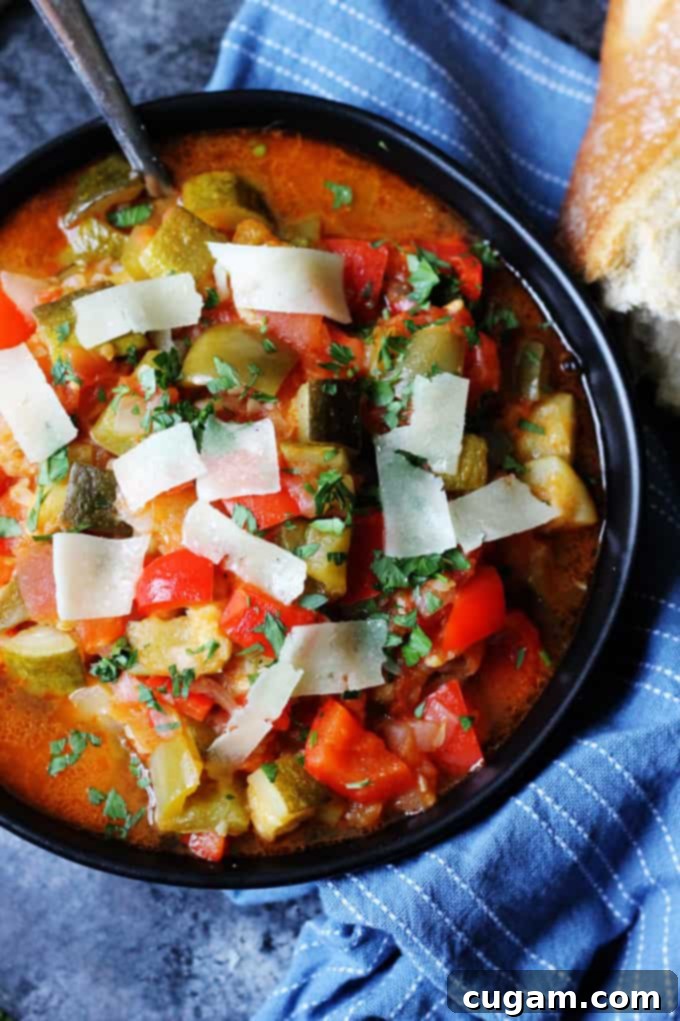
Explore More Spanish Culinary Delights
If your taste buds are now craving more authentic Spanish flavors after savoring the Pisto Manchego, we invite you to explore some of our other all-time favorite recipes that truly capture the essence of this vibrant cuisine. From hearty main dishes to delightful tapas, there’s a Spanish adventure awaiting in your kitchen:
- One-Pot Chicken Saffron Rice with Peas and Olives
- Pan Con Tomate (Garlic Tomato Toast)
- Garlic Shrimp (Gambas al Ajillo)
- Romesco Sauce
- Spanish Potato Salad with Olives and Chorizo
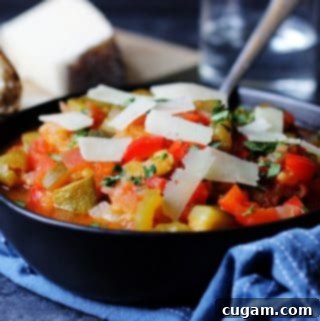
Pisto Manchego (Spanish Ratatouille)
Print
Pin
Rate
Ingredients
- 2 tbsp Olive Oil Extra Virgin to sautee veggies
- 1/2 Vidalia Onion Or Small Spanish Onion, chopped
- 3 cloves Garlic Peeled and chopped
- 2 Zucchini Medium size, cut into small cubes
- 1 Red Bell Pepper Cut into small cubes
- 1 Green Bell Pepper Cut into small cubes
- 8 Tomatoes Medium size like “on the wine” or “Roma”, peeled and chopped
- 1 tbsp Sherry Vinegar
- Salt & Pepper to taste
- 1/4 teaspoon Spanish Smoked Paprika Optional, for a little heat and smoky flavor
- 1 tbsp Shaved Manchego Cheese Optional
- 2 tbsp Olive Oil To drizzle on finished – optional
- Fresh Chopped Parsley to Garnish
Instructions
-
Bring a pot of water to boil. Add tomatoes and leave them for 2-3 minutes until the skin starts to break. Remove to a colander and let cool off. Then peel the skin and chop your tomatoes.
-
Preheat olive oil in a dutch oven or another heavy pan with the lid, on a moderate heat. Then saute onions for 5 minutes, uncovered.
-
Add chopped garlic and saute for few more minutes.
-
Add peppers and cook for 5 more minutes.
-
Reduce the heat to low, add zucchini and tomatoes, a little bit of salt and pepper and put the lid on. Let cook covered for about 30 minutes, stirring it occasionally.
-
Check for seasoning and adjust with salt and pepper as needed. Add smoked paprika, if using, sherry vinegare, and mix all together.
-
Place it in a serving bowl, drizzle extra virgin olive oil, shave over some Manchego Cheese, sprinkle on some parsley and serve with bread. Enjoy!
Nutrition
Read more about the author Edyta here or follow Eating European on social media: Facebook, Instagram, Pinterest, and Twitter.
